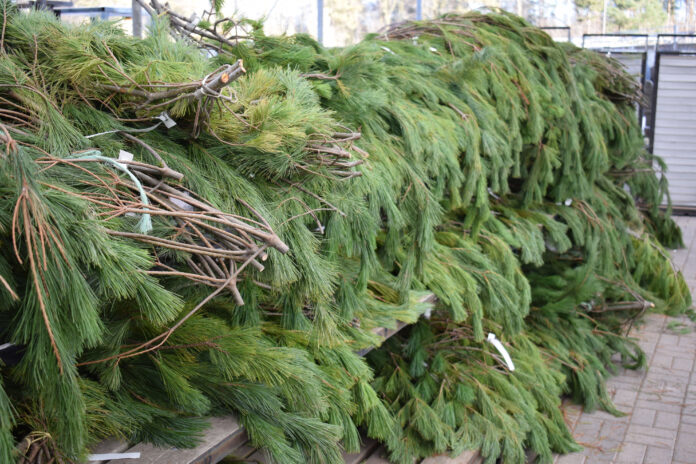Your front door and balcony are begging for a holiday-appropriate planter or two.
They require little water and virtually all the most popular holiday cuttings can be grown in your garden or found locally. Canadians are blessed to live in a landscape with a holiday aesthetic. In most cases, you could still plant most of these or create a list to add to your spring planting plans.
Here are our favourite plants for holiday cuttings:
- Red osier dogwood (Cornus sericea) is one of the most popular holiday cuttings. The red branches add colour and structure to any holiday décor. We often recommend red osier as a garden shrub as it is a native species with year-round interest which birds and butterflies seem to love. In the wild, it prefers moist areas and can stand up to a hard pruning year after year which makes it a star candidate for holiday cuttings.
- Staghorn Sumac (Rhus typhina) is a native shrub that is widely planted. After you have enjoyed the fall colours of a sumac’s foliage, trim some of the large, clustered seed pods for ornamental display but make sure to leave some behind for the birds to enjoy this winter. Native sumac grows aggressively on most soils, which makes them a popular option on large properties especially on declines where soil erosion can be a problem.
- White paper birch (Betula papyrifera) is a native tree featuring white bark that contrasts well with red osier dogwood. White paper birch favours full sun but cool, moist soils which is why you often find them on the outer fringes of swamp lands and forests. Paper birch are short lived but fast growing, often putting on 24-36 inches or up to a meter per year, which means they are a good candidate for frequent pruning to supply your annual holiday display. Indigenous peoples made canoes out of paper birch bark.
- Eastern white cedar (Thuja occidentalis) An obvious evergreen for holiday décor. Happy in damp soil, it also makes a great hedge. Hedging cedar lends itself to pruning. The best source for cedar cuttings is to befriend a neighbour with cedar growing on their property. Be nice to them and they will no doubt let you poach some branches.
- Mountain Ash (Sorbus americanus) a native tree that birds love for its clusters of orange iron-rich berries, which also happen to look great in a holiday arrangement. Suitable to a range of growing conditions and tolerates clay soil.
- Euonymus is a large genus of popular broadleaf evergreens that are largely native to Asia, and popular in North American gardens. You can find euonymus with various leaf patterns and colours to suit your design vision.
- Blue Princess Holly (Ilex x meserveae ‘Blue Princess’) is the cultivar of holly that most people associate with the ‘holly-days’, featuring shiny dark blue-green spiny leaves and dark red berries. Requires pollination from the male pollinator Ilex x meserveae ‘Blue Prince’ to fruit. For many, a Blue Princess holly can stand on its own as a holiday display.
Our short list of holiday branches also includes bittersweet vine, juniper cuttings and pine, spruce, and fir tree boughs. When harvesting from the wild it is advisable not to take more than 1/3 of a plant and never without the permission of the property owner. If you find yourself looking out at your garden void of holiday cuttings, perhaps put a gift card on your list for a local nursery to start populating your holiday cutting garden for next year.
Mark Cullen is an expert gardener, author, broadcaster, tree advocate and Member of the Order of Canada. His son Ben is a fourth-generation urban gardener and graduate of University of Guelph and Dalhousie University in Halifax. Follow them at markcullen.com, @markcullengardening, and on Facebook.


